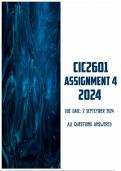, PLEASE USE THIS DOCUMENT AS A GUIDE TO ANSWER YOUR ASSIGNMENT
Please note that the author of this document will not responsibility for any plagiarizing you
commit.
Section A
1. Create a technology-integrated lesson for your specific phase (Foundation/ Senior/
Intermediate or FET) in a subject of your choice, by making use of the lesson plan template
provided.
Lesson Plan
Name and student number:
Grade: 6 Duration of the lesson: 60 minutes
Lesson Topic: Energy and Lesson Sub-Topic: Electric Circuits
Change
Type of Lesson (Theory or Practical): Practical
Caps Page Number: 14
LTSM (s):
Interactive whiteboard
Laptops/tablets
Simulation software (e.g., PhET Interactive Simulations)
Electric circuit kits (batteries, wires, bulbs, switches)
Projector
Lesson aims (on different cognitive levels)
At the end of the lesson, the learner should be able to:
Knowledge: Identify components of electric circuits (batteries, wires, bulbs, switches).
Comprehension: Explain the difference between series and parallel circuits.
Application: Construct simple series and parallel circuits.
Analysis: Compare the functioning of series and parallel circuits.
Evaluation: Assess the advantages and disadvantages of series and parallel circuits in various
applications.
Name, explain and motivate the teaching strategy you will follow and apply.
Inquiry-Based Learning: This strategy encourages students to ask questions, explore, and engage
in hands-on activities to understand electric circuits. It promotes critical thinking and
problem-solving skills by allowing students to investigate and find solutions on their own.
Motivation: Inquiry-based learning helps students take ownership of their learning by actively
participating in the discovery process, making learning more engaging and meaningful.
Name, explain and motivate the teaching method you will follow and apply.
Demonstration and Experimentation: Begin with a teacher-led demonstration to introduce basic
concepts, followed by student-led experiments where they construct and test their own circuits.
Motivation: Demonstrations provide a clear and visual explanation of concepts, while hands-on
experimentation allows students to apply what they have learned, reinforcing their understanding
through practice.





